13. Locking Horns With John Williams
This piece is a little longer than usual because I have more time due to the Coronavirus…or maybe less time! ! Before I start this story I would like to send a shout out to two of my closest friends in Australia. Dallas and Judy Booth were the first two friends my wife and I met when we moved to Australia. Love you guys and miss our laughter.
Musical Director for Two National TV Shows – Some Great Fun
When I lived in Australia, after I left Yamaha Music, I was the music director for two different, national television shows. They were both on the same network, Channel 7 TV, based out of Sydney. By the way, in my opinion Sydney is the most beautiful city in the world.
“Have a Go”
One show was like the “Gong Show” in the states, but, it was called “The Have A Go Show“.
The Wild and Crazy “Have A Go Show” Crew – My Mom, visiting, stands to my left
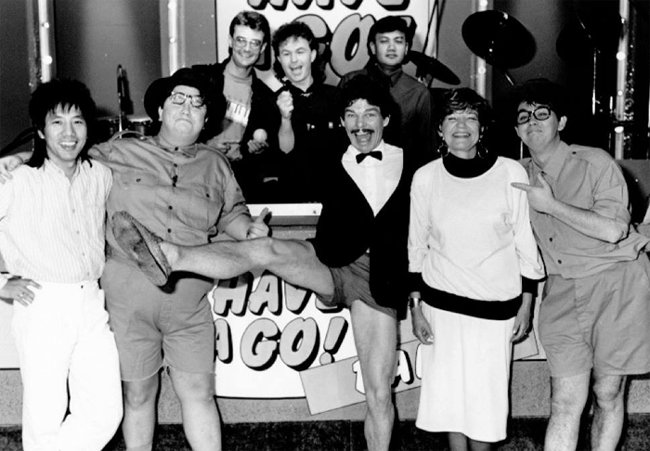
The “Have A Go” Theme Song (audio clip)
Rehearsing for the “Have A Go Show”
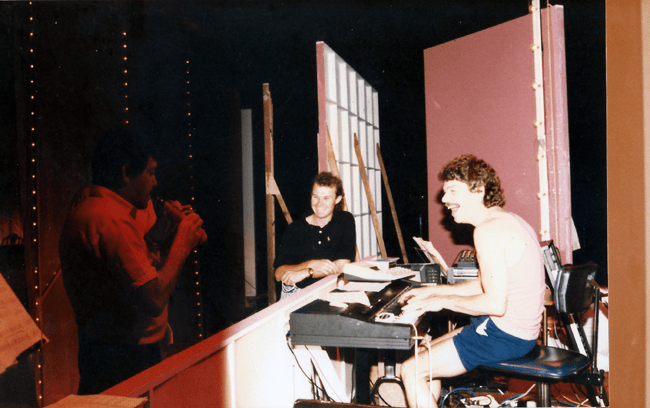
“Late Night with Jono and Dano”
The other show was a “live” nighttime variety show called “Late Night with Jono and Dano“. It was on every Saturday night and was very similar to David Letterman’s “Late Night Show” in America. It was advertised as “live” but, actually, it was broadcast with a slight delay – airing about an hour after it was filmed. I wrote both theme songs.
Late Night With Jono and Dano – theme song written by Dave Kimber
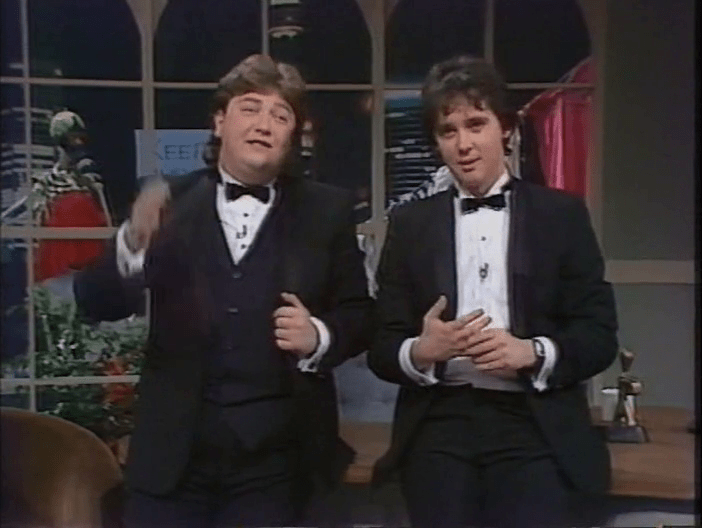
We had a terrific four piece band and every week we had a rotating fifth member, often great players like Tommy Emmanuel as a second guitar player – or, we might add a conga player or a sax player to the band. We always had great guest artists from Australia and American artists that were touring Australia, like Seals and Crofts and the Platters. When the Platters were on the show there was only one original member left. He was a nice guy and I joked with him that maybe he needed to change the name of the group to “The Platter”. Our guitar player, Rex Goh, was one of the premier guitar players in Australia. He was the guitar player for the world famous group “Air Supply” and he had toured the world with the group several times. The piano player of Air Supply, Frank Esler-Smith was the music director of the group and arranged all the beautiful orchestra parts for their numerous big hit records like “I’m All Out of Love”, “Here I Am”, and “Nothing at All”. I’ll come back to Frank later in the story as he is an integral part of this tale. Being the music director, I had certain perks and one of them was choosing who was in the band.
Paul Knipe was a well known drummer and knew most of the musicians in town. He was a superb drummer and he and I became very good friends back then and are still good friends, today. So, I had my band almost completely assembled but it seemed that I just couldn’t find the right bass player. Two friends of mine, Geoff Watson and Simon Ledley, had a small recording studio at the back of Greg Hutching’s music store in Bondi Beach. I was telling Geoff that I was having a problem finding the right bass player and he said, “You should meet our engineer, Tim Ryan.” Tim turned out to have all the right qualities. He was a really nice, genuine, funny, and handsome guy, (all the girls in the audience loved him.) And oh yeah, he was also a great musician with a good ear. Tim and I became great and lasting friends. He is still doing music and is co-owner of one of the biggest recording studios in Australia, called Trackdown Studios.
Jono and Dano were the number one radio personalities in Australia and they hosted both of our shows. Jonathan Coleman had been a TV star since he was a child and he knew everyone in the business. He was asked to write a TV advertisement for John Singleton, who owned a huge advertising company and was a big celebrity in his own right. Jono asked me to help him write the song for his ad. We used the Gold Medal Australian swim team to lip sync the song that we wrote. It was for “Gold Medal Bread” and it was called, “I’m a White and Bran Fan”. That was a new bread for the Buttercup Bakery company. It was a catchy little song but it was not rock and roll. It was more child-like and the swimmers thought it wasn’t “tough enough” for them. Anyway, John Singleton loved it, and the ad went on to win several awards and sell a lot of bread. And I went on to write 40 more ads for John Singleton.
Branching out, writing some major TV themes
During the production of our TV show, “Late Night with Jono and Dano”, Robin Heaps who was the vice president of Channel Seven TV asked me to write a promo tune for a big stock car race called the James Hardy Bathurst 1000. It was going to be a sixty second TV commercial. I went to my recording studio and wrote it and, then, went to a bigger studio run by a great engineer named John Sayers and recorded it. It came out great and the Channel 7 executives loved it. I had never written this kind of a promo for a TV show before, even though I’d written both theme songs for the shows I’ve mentioned. I really wasn’t sure how much I should be paid for this kind of project – I really didn’t have a clue as to what sort of payment I should expect or ask for. I had an old friend in California who was partners with Mike Post in Hollywood. He wrote many of the TV show themes like “L.A. Law”, “Hill Street Blues”, “NYPD Blues”, “Greatest American Hero”, “Rockford Files”, and many more. My friend, and Mike, told me that I should calcaulate my expenses and add an additional $10,000….plus royalties would come later. I delivered the finished product to Robin. After we had heard it several times, Robin clapped his hands and said “I love it”. Where’s the bill?” As I handed him the bill I was preparing myself, mentally, to explain why the total price was over $12,000. I considered that there might be some haggling over my bill. Robin looked at the bill and said, “I love it. I would have paid more!” And I said, “Well, next time I’ll come and see you before I write out the final bill.” And for every job, thereafter, that’s exactly what I did.
Bathhurst 1000 Promo (audio clip)
The “Late Night with Jono and Dano” show was recorded in the early evening every Saturday night and went to air later that evening so I had a lot of time during the week to do other things besides get ready for the next “Late Night” show. During this time, Channel Seven asked me to write the music for advertisement for “The America’s Cup“. This was a big thing all over the world, a rich man’s sport. The final races were between Australian and American yachts. One of the yachts was called the Kookaburra, sponsored by Channel Seven. I wrote a driving song using lots of strings, played like the “Psycho” strings. I had my friend, Nick Hill write the lyrics and Mark Williams sang the song with Madalyn. The film crew put great pictures of the yachts racing and it was played all the time across the Nation. I hired four of the best male session singers in Sydney to shout at the end of the song…”Be There.” That was channel seven’s catch phrase. It was a bit overkill but what the Hell.
America’s Cup Promo (audio clip)
My Biggest Job, Yet
A couple of weeks later, my angel, Robin Heaps called me from Channel Seven and asked me if I could write and record the new station id. He said, “This will be your biggest job yet. You have to impress the president and the board of directors.”
I learned that Channel Seven had sent a crew to America to bring back the numeral “7”, spinning around, using the Olympic colors. It was just a thirty-second clip but I was told by two people, in the know, that the short clip had cost more than $200,000 to produce. At that time, using computer technology to generate graphics was still in it’s infancy, and, such graphics didn’t come cheap. This would be the first time Channel 7 had used digital graphics for their station id. The graphics were absolutely breathtaking but, still, what a price! The musical piece had to be huge and exciting with a full orchestra – strings and the works. But, there was slight problem. I didn’t read music, just chord charts. I played by ear. So I searched and found an arranger. In my studio, at home, I recorded my new piece of music with my synthesizers. For those of you who don’t know: Synthesizers are keyboards that can sound like any instrument in the orchestra. My arranger, Marc, transcribed the different parts for the orchestra from my original audio tracks. I hired a studio that would accommodate a 36 piece orchestra and we recorded many variations of the station id tracks. Marc conducted the orchestra and I produced the session which meant I was in the recording booth with the engineer and I could push a talk button and talk to anyone in the orchestra that I wanted. I told a few jokes to get the orchestra loosened up and then we went to work. The orchestra cost me $6,500 for three hours so I didn’t tell many jokes. My engineer for this and many other sessions was John Bee. He was great and he became one of my best friends.
When I was finished with my music, and they put the visual with the music, the brilliant colors made my music sound more elegant.
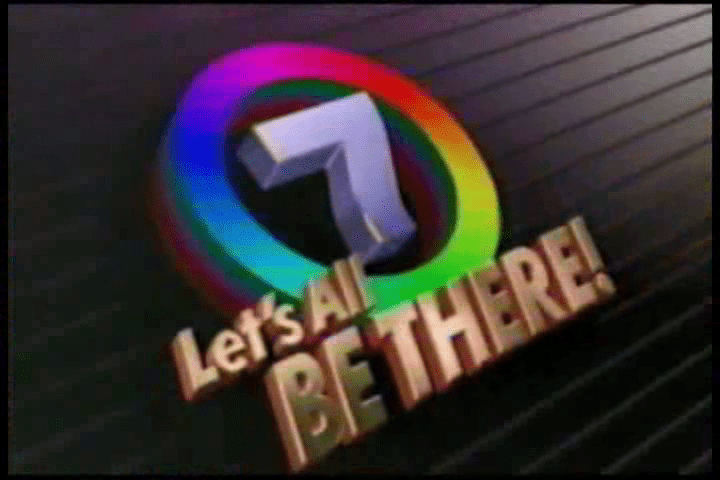
Two days later I was driving out to Channel Seven to play the finished piece of music to the President, the Board of Directors, and my angel, Robin Heaps. I had synced my new music to the digital spinning “7” and everyone loved it and wanted a copy. Robin was very proud of me. When we finished, we went back to Robin’s office and I asked him how much I should charge for this “15 second very important piece of music”. The recording session cost me a lot of money and I handed Robin an unfinished bill with my expenses and added $10,000 for my work. Robin told me that because the President loved the piece of music that I could charge what I wanted “within range”. “What did that mean?” I asked. Robin gave me a wink and told me to add on another $10,000 for myself. I was elated. Robin’s “within range” was a lot more than my “within range” would have been.
For the next several months, I did my TV show and many promos for Channel Seven as well as many ads for John Singleton. While working on John’s ads was not as lucrative as the Channel Seven promos they were very fun to do.
Even More TV Themes, and Some Heady Times!
The New Year 1988 was coming around and Channel Seven asked me to write the new Channel Seven theme song for 1988. Robin said that the only lyric would be “Let’s Celebrate ’88”, and, they would have a new ,beautiful visual to go with my new music. I had been working with a new musical friend named Derek Williams, a very talented and funny guy. We wrote several ads together and we recorded at his computerized studio. He was a monster music reader and arranger. We both wrote this new theme song for a full orchestra. We wrote the piece on synthesizers and then Derek transcribed the notes for the individual instruments. The session with the orchestra was really inspired and downright fun. Derek was conducting the orchestra and I was in the control room talking to Derek through headphones. I was surrounded by all those knobs and buttons like the pictures you see in pictures of a recording studio. These were all being used. We recorded several versions and then brought in some great studio singers from Sydney and they sang “Let’s Celebrate 88!”
Channel Seven put several versions of pictures to the tune and I have to say that that piece of music was played at least ten to fifteen times a day. By the end of 1988 I was more than ready to do a new song, and, to never hear the “88” theme again!
Celebrate 88 Theme (video clip)
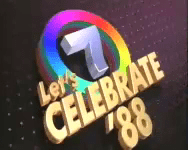
One day my wife and I were watching the “Have a Go Show” on TV which aired every day at 5:30 p.m. across Australia. We filmed all five shows every Saturday. The show started with my theme song and the first break had two of my ads from John Singleton in it. One was from Buttercup bread and the other one was for the Australian Lotto. At the end of the show they played my theme song again followed by a movie promo with my music. Then they showed the Seven id that I recorded with the orchestra. It was pretty heady stuff. I was in seventh heaven.
Right then my phone rang and it was my Channel 7 angel, Robin Heaps. He said for me to come out to the studio so he could talk to me about a new job. He told me that this would be my biggest and most important job yet. I asked what it was and he said, “Just come out here, right now.”
My Biggest Challenge Yet – Enter John Williams
I drove to the 7 studio and Robin was waiting for me. I asked, “What’s up?” He said that John Williams, the great composer from the USA, who wrote the music to “Superman”, “Jaws”, “Star Wars”, and many more had just written the new theme for NBC News in the States. Channel 7 wanted me to compose a brand new theme for their news. Robin said they wanted the new theme to, “Be like John Williams, but, NOTHING like his.” I listened to John Williams theme and it was fantastic. In fact, forty years later NBC and MSNBC are still using it in the States.
Robin and I talked about the theme and he asked me to go home and work on different ideas and check back with him. Back then, I was not opposed to staying up all night in my studio and working on it with all of my synthesizers. It was a wonderful night. As the night wore on, it was like I was channeling different famous composers from the past. The next day when I drove out to see Robin and played my ideas he would say, “Hey, that has a Mozart feel or a Bach feel…” – or some other composer that I barely knew. Robin had a more extensive classical background then me.
We agreed upon several ideas that I should expand upon. Both of us liked one idea best, and, eventually that idea became the main hook of the song. I worked for several nights on the orchestra arrangement using lots of strings and brass. I wrote a two-and-half-minute piece, a thirty second piece and tent second version.
Well, now I needed a collaborator who could write the music for the orchestra instruments. I had used different arrangers for each of my orchestra jobs and so I was looking for someone new…
I called my old friend Rex Goh, the guitar player in our TV band who was also the was the the guitar player in “Air Supply”. I asked him if he knew any great arrangers and he told me about Frank Esler Smith who was the keyboard player and the arranger for Air Supply. He had done all of their giant hit records around the world.
I called Frank and we met for a drink and I explained the job and then played him what I had so far out in my car. Besides the main piece of music we had to make over twenty-four variations of the theme to play behind any type of news story. The smallest was three seconds long and the longest was nintey seconds.
Frank and I worked together at my little studio and at his house. He was a lovely person and had a great sense of humor and we became instant best friends. He was very accommodating as an arranger. I would say , “I hear woodwinds here and he would find and oboes on the synthesizers and he would play exactly what I was hearing. Or, Frank might have another idea and we would decide with our ears which way to go.
The day of the big session, we had a very large orchestra fill the recording hall. I was in the booth with the recording engineer and about a thousand buttons and switches and was surrounded by glass so I could see all the players in the orchestra and Frank with his directors baton out in the main room. It was very exciting to see all of these superb musicians from the Sydney Philharmonic Orchestra come into the studio with violins, trumpets and harps. My favorite orchestra instrument is the french horn and I had three of them that day.
Orchestras are rented in three hour blocks. You have to pay union scale just like hiring a guitar player for a session. But with an orchestra you have to multiply the three hour fee times by thirty-six, or, however many players you have in your orchestra. If you go over by one minute you have to pay the whole orchestra for another three hours. So, Frank and I worked fast.
We started by learning the main theme which was 60 seconds then a 30 second version then about twenty short bit that the station used going in and out of the news broadcast.
When we had finished we released everybody except the three french horn players. I had an idea for a short musical bit using just the french horns playing the main theme which was six notes.
For the next two days we mixed all the tracks down. “Mixing” means we adjusted all the tones and volumes on each instrument so the whole orchestra would sound blended. The final mix on the tracks sounded great. Robin Heeps stopped by the session but didn’t stay too long. When I was finished I called Robin and he set up a time to see the President of channel 7, the head of the news department, the publicity head, Robin and myself to hear the new news theme. When I arrived at Robin’s office with the tapes, I said,”Where are we going to listen to these?” Robin said, “Frank wants to listen to them on his new Jaguar sound system.” So, we all walked out to the parking lot and jumped in his new car.
We started with the sixty second version. I was thrilled. Everybody was oohing and aahing. The president loved the new theme. Frank, who was the news director, kept talking in a very excited voice, about different film footage they could shoot from the news helicopter that would go with different parts of my music. It was a big success. The people that mattered the most at the station, loved it and Robin was beaming because his protege…me…did well. He was very proud of me. In fact in Robin’s office he had a framed page from the Paul Whiteman’s orchestra from the 1930’s. It was the pay page including the signature from each of the musicians and the singer happened to be Bing Crosby and who signed for $150 a week. I had always loved that framed page and used to look at it whenever I was in Robin’s office. Before I left his office and we had settled on a whopper bill for the project, Robin took the framed pay page off of the wall and gave it to me with a big smile. As he handed it to me.he said, “David, I am so proud of you. You came through and everybody loved your theme.” Robin also wrote a note to Frank Esler-Smith for all of his creative help and I gave it to Frank, along with a big check.
I had several tapes with me, including the master tapes. These were huge tapes. I also had 1/4 inch tapes for each of the pieces. All together I had twentty-eight separate pieces of music.
The next day, I got a phone call from Robin. I was worried. “Is there anything wrong?” I asked. “Everybody around here likes your music. As a matter of fact we need more music, ” said Robin. “For what?” I asked. Robin explained to me that all my pieces were powerful and majestic sounding, but what we need is a gentle, sentimental version of your theme. I understood and went to work that day and night. And the next morning, I played what I had for Frank and he transcribed the orchestra parts for a thirty-second, very pretty version highlighting the flutes and a harp. So, I hired the orchestra again and went in recorded this piece of music. In less than four days I was in Robin’s office playing him the new gentle version. He beamed and said, “Yes, this is perfect. “We can use this for sad, melancholy and somber news stories”, he said. Robin wrote out a new, hefty check before I even gave him a bill. Here’s a sampling of various pieces of the Kimber news theme:
Channel 7 News Theme – complete (audio clip)
Channel 7 News Theme – short version (audio clip)
Channel 7 Morning News Theme (audio clip)
My Biggest Project Goes Up In Smoke!
Three days later, I received a phone call from Robin. He actually said, “David, are you sitting down?” “Yes….why? What happened?”, I asked. Robin continued, “You’re not going to believe this, but it looks like we are not going use your new news music.” “Why?”, I asked. He said, “David, have you ever heard of Christopher Skase?” “Yes,” I said. “Isn’t he a billionaire?” “Yes, he is. And he just purchased Channel Seven TV”, said Robin, “What does that have to do with my music?”, I asked. Robin answered, “Well, before he bought our TV station he was in L.A. and he bought the new John Williams news theme for his new Australian TV station – us. Nobody around here knew anything about the buyout or him buying the John Williams package.” I said to Robin, “Boy, sitting down wasn’t enough. Robin. Do you mind if I lay down?”
Billionarie Christopher Skase
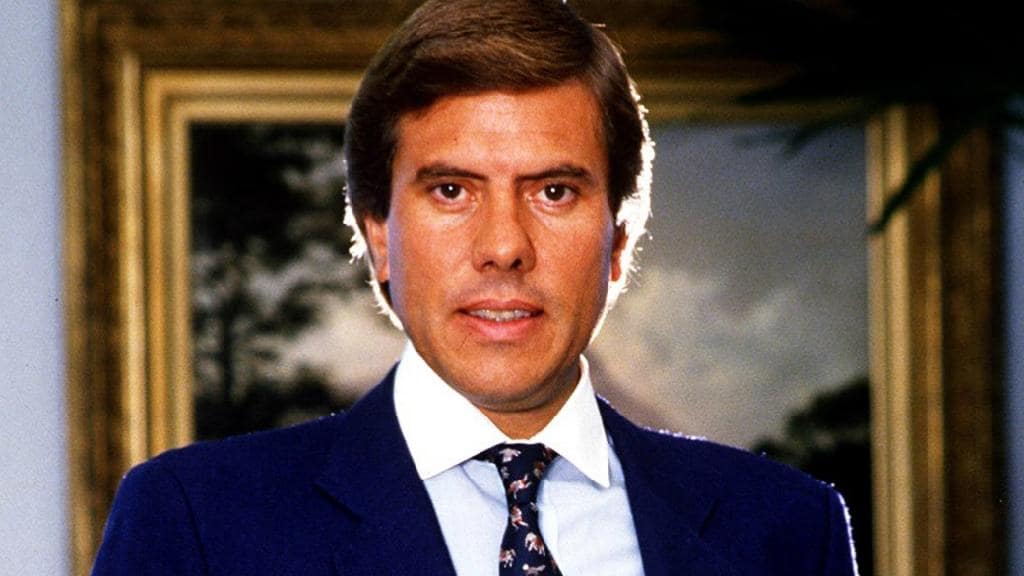
“Well, here is what we are going to do,” Robin said. “Number one, you are going to keep all the money for all your hard work. And, right now sending you back all your tapes including the master tape by courier. David, I want you to keep them. They are all still in your name so you own them again. And you are free to sell them anywhere in the world.” I was crestfallen. All that work and I was looking forward to hearing my music on the nightly news for many years to come. The royalties would have paid for a new house. Trying to sell my news theme in Europe is a whole different story.
They say that “money isn’t everything” but it’s not a bad thing to have plenty of money, either. My musical projects in Australia had been fulfilling as a musician, and, profitable beyond my wildest dreams – which certainly wasn’t a bad thing. But fickle fate, in this case, had intervened to rob me of a little bit of immortality. I was paid really well for my news themes but, still, after so much work and so much anticipation not having my music played every day on the national news was a big “downer”. The money, in this case, was actually less important than the recognition of my work – amazingly!
But when I look back on that magical time in Australia, making such wonderful friends and wonderful music, I’m going to say that John Williams and I are both winners – I guess we’ll just call it a draw.
I wonder if they have a section on Craigslist for selling, “Slightly Used News Themes”?

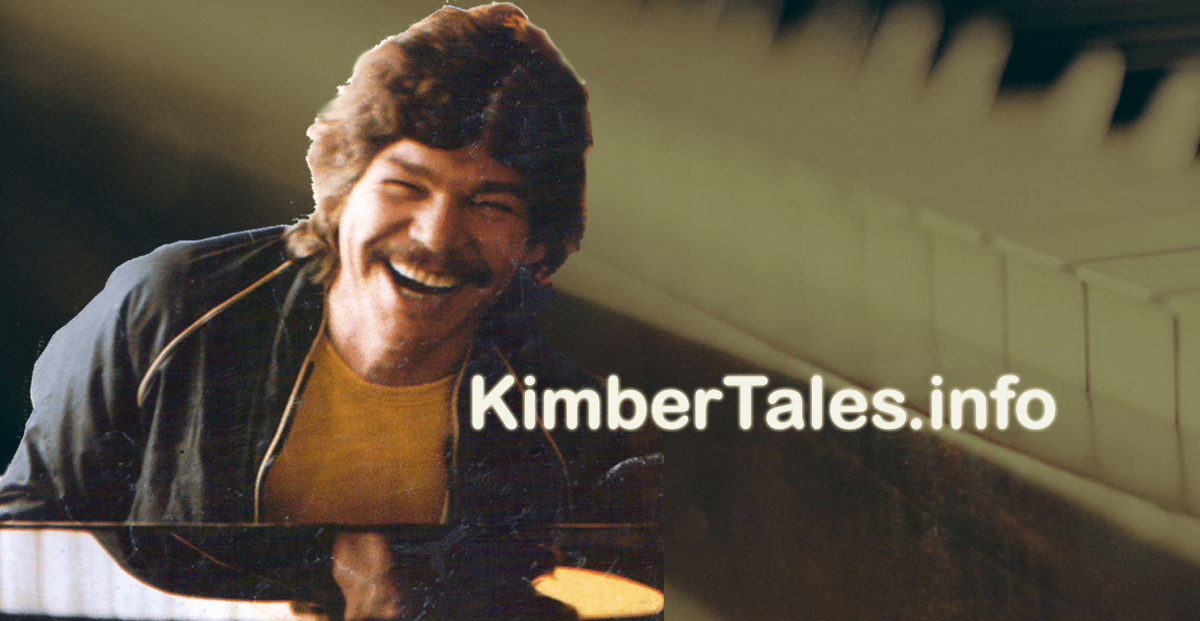
I love your stories Dave. Especially the John Williams piece. I love his music. I’m surprised you never mentioned it to me while at Neithercut. You’re a very talented friend.
Always interesting reads Dave. Short or long I enjoy taking the time to read. Keep them coming and good to see you back…and healthy
I pitched Mike Post some demo songs written by Mike Moore of YELLOW ROSES ON HER GOWN to Mike Post circa ’72 and we talked about stuff we heard when we were young that really excited us. He mentioned Manhattan Spiritual and said he wanted to do a remake. I was also pitching some classical based rock material to Jack Gold and Mike Melvoin at the time. Sounds like you too were smitten with Manhattan Spiritual of ’59 since the horn stabs in one of your works have that same vibe.
Dave- The Arp Explorer is rarely mentioned. I used one for session work in the Philly area in the mid 70s. Gerson Rosenbloom of Medley Music in Bryn Mawr, PA would loan me stuff that came in from the NAMM shows. The Explorer was a dumbed down Odyssey and easy to use. He also had the Ensoniq MIRAGE to loan out. Gerson and his dad Harry were investors in Ensoniq and Martin since the companies were close by and also Ibanez. Gerson is still active and on the board at SWEETWATER. Did Ensoniq ever ship anything to Australia?
Dave, another great story. How can one guy be both a great musician and writer? Really enjoy these stories. Keep them coming my friend.
I look forward to reading your life in music stories! You’ve had a fascinating life! Thanks for sharing.